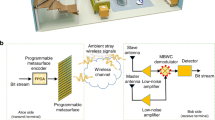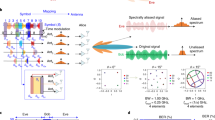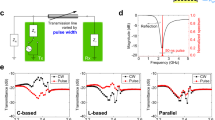Abstract
In current wireless communication systems, sophisticated attack strategies at the physical layer—the electromagnetic wave signals carrying the information—leave traces in the physical environment, which mean such attacks are typically detectable. This may not be the case for future—sixth generation and beyond—wireless networks, whose current vision relies on the concept of smart radio environments, which use metasurfaces to manipulate wave signals in unconventional ways. Here we report metasurface-enabled smart wireless attacks at the physical layer. We illustrate both passive and active operational modes. In the passive mode, an attacker is capable of eavesdropping on the wireless information transfer of a target by controlling the programmable metasurface, without actively radiating any signal. In the active mode, an attacker can eavesdrop as well as falsify the wireless communications by sending deceptive information to the target. In both operational modes, the detectability of the attacker can be minimized. As a proof of concept, we create an attacker prototype working in the Wi-Fi band at around 2.4 GHz, and demonstrate its ability to hack wireless data streams. Our results highlight potential security threats for next-generation wireless networks, and emphasize the need to develop suitable mitigation strategies and specific security protocols at an early stage.
This is a preview of subscription content, access via your institution
Access options
Access Nature and 54 other Nature Portfolio journals
Get Nature+, our best-value online-access subscription
$29.99 / 30 days
cancel any time
Subscribe to this journal
Receive 12 digital issues and online access to articles
$119.00 per year
only $9.92 per issue
Buy this article
- Purchase on Springer Link
- Instant access to full article PDF
Prices may be subject to local taxes which are calculated during checkout




Similar content being viewed by others
Data availability
The data that support the findings of this study are available from the corresponding authors upon reasonable request.
Code availability
The code that supports the findings of this study is available upon reasonable request from L.L.
References
Larsson, E. G., Edfors, O., Tufvesson, F. & Marzetta, T. L. Massive MIMO for next generation wireless systems. IEEE Commun. Mag. 52, 186–195 (2014).
Albreem, M. A., Sheikh, A. M., Alsharif, M. H., Jusoh, M. & Mohd Yasin, M. N. Green internet of things (GIoT): applications, practices, awareness, and challenges. IEEE Access 9, 38833–38858 (2021).
Cui, T. J., Qi, M. Q., Wan, X., Zhao, J. & Cheng, Q. Coding metamaterials, digital metamaterials and programmable metamaterials. Light: Sci. Appl. 3, e218 (2014).
Arun, V. & Balakrishnan, H. RFocus: beamforming using throusands of passive antennas. in Proc. 17th USENIX Symposium on Networked Systems Design and Implementation 1047–1061 (USENIX Association, 2020).
Li, L. et al. Intelligent metasurface imager and recognizer. Light: Sci. Appl. 8, 97 (2019).
Liu, S. & Cui, T. J. Concepts, working principles, and applications of coding and programmable metamaterials. Adv. Opt. Mater. 5, 1700624 (2017).
Cui, T. J., Liu, S., Bai, G. D. & Ma, Q. Direct transmission of digital message via programmable coding metasurface. Research 2019, 2584509 (2019).
Shuang, Y. et al. One-bit quantization is good for programmable coding metasurfaces. Sci. China Inf. Sci. 65, 172301 (2022).
Basar, E. et al. Wireless communications through reconfigurable intelligent surfaces. IEEE Access 7, 116753–116773 (2019).
Pan, C. et al. Reconfigurable intelligent surfaces for 6G systems: principles, applications, and research directions. IEEE Commun. Mag. 59, 14–20 (2021).
Cheng, Q. et al. Reconfigurable intelligent surfaces: simplified-architecture transmitters—from theory to implementations. Proc. IEEE 110, 1266–1289 (2022).
Di Renzo, M. et al. Smart radio environments empowered by reconfigurable intelligent surfaces: how it works, state of research, and road ahead. IEEE J. Sel. Areas Commun. 38, 2450–2525 (2020).
Flamini, R. et al. Towards a heterogeneous smart electromagnetic environment for millimeter-wave communications: an industrial viewpoint. IEEE Trans. Antennas Propag. 70, 8898–8910 (2022).
Akyildiz, I. F., Kak, A. & Nie, S. 6G and beyond: the future of wireless communications systems. IEEE Access 8, 133995–134030 (2020).
Martini, E. & Maci, S. Theory, analysis, and design of metasurfaces for smart radio environments. Proc. IEEE 110, 1227–1243 (2022).
Zheng, P. et al. Metasurface-based key for computational imaging encryption. Sci. Adv. 7, eabg0363 (2021).
Georgi, P. et al. Optical secret sharing with cascaded metasurface holography. Sci. Adv. 7, eabf9718 (2021).
Shaikhanov, Z., Hassan, F., Guerboukha, H., Mittleman, D. & Knightly, E. Metasurface-in-the-middle attack: from theory to experiment. in Proc. 15th ACM Conference on Security and Privacy in Wireless and Mobile Networks 257–267 (ACM, 2022).
Zhao, H. et al. Metasurface-assisted massive backscatter wireless communication with commodity Wi-Fi signals. Nat. Commun. 11, 3926 (2020).
Li, L., Zhao, H., Liu, C., Li, L. & Cui, T. J. Intelligent metasurfaces: control, communication and computing. eLight 2, 7 (2022).
Wu, B. et al. On the selection of the number of bits to control a dynamic digital MEMS reflectarray. IEEE Antennas Wireless Propag. Lett. 7, 183–186 (2008).
Shuang, Y. et al. Programmable high-order OAM-carrying beams for direct-modulation wireless communications. IEEE Trans. Emerg. Sel. Topics Circuits Syst. 10, 29–37 (2020).
Zhang, N. et al. Programmable coding metasurface for dual-band independent real-time beam control. IEEE Trans. Emerg. Sel. Topics Circuits Syst. 10, 20–28 (2020).
Saifullah, Y. et al. Dual-band multi-bit programmable reflective metasurface unit cell: design and. experiment. Opt. Express 29, 2658–2668 (2021).
Zhang, X. G. et al. Polarization-controlled dual-programmable metasurfaces. Adv. Sci. 7, 1903382 (2020).
Chen, K. et al. Active anisotropic coding metasurface with independent real-time reconfigurablity for dual polarized waves. Adv. Mater. Technol. 5, 1900930 (2020).
Yener, A. & Ulukus, S. Wireless physical-layer security: lessons learned from information theory. Proc. IEEE 103, 1814–1825 (2015).
CST Studio Suite 3D EM Simulation and Analysis Software; https://www.3ds.com/products-services/simulia/products/cst-studio-suite/
Lu, X., Lei, J., Shi, Y. & Li, W. Intelligent reflecting surface assisted secret key generation. IEEE Signal Process. Lett. 28, 1036–1040 (2021).
Leung-Yan-Cheong, S. & Hellman, M. The Gaussian wire-tap channel. IEEE Trans. Inf. Theory 24, 451–456 (1978).
Acknowledgements
This work was supported by the National Key Research and Development Program of China under grant nos. 2021YFA1401002, 2017YFA0700201, 2017YFA0700202 and 2017YFA0700203. T.J.C. acknowledges support from the National Natural Science Foundation of China under grant no. 62288101.
Author information
Authors and Affiliations
Contributions
L.L., T.J.C. and V.G. conceived the idea and wrote the manuscript. M.W. and H.Z. designed and developed the system and conducted the experiments. All authors participated in the data analysis and interpretation, and read the manuscript.
Corresponding authors
Ethics declarations
Competing interests
The authors declare no competing interests.
Peer review
Peer review information
Nature Electronics thanks the anonymous reviewers for their contribution to the peer review of this work.
Additional information
Publisher’s note Springer Nature remains neutral with regard to jurisdictional claims in published maps and institutional affiliations.
Supplementary information
Supplementary Information
Supplementary Notes 1–4, Figs. 1 and 2 and Table 1.
Supplementary Video 1
Video recording of the experimental results of a metasurface-enabled active wireless attack.
Rights and permissions
Springer Nature or its licensor (e.g. a society or other partner) holds exclusive rights to this article under a publishing agreement with the author(s) or other rightsholder(s); author self-archiving of the accepted manuscript version of this article is solely governed by the terms of such publishing agreement and applicable law.
About this article
Cite this article
Wei, M., Zhao, H., Galdi, V. et al. Metasurface-enabled smart wireless attacks at the physical layer. Nat Electron 6, 610–618 (2023). https://doi.org/10.1038/s41928-023-01011-0
Received:
Accepted:
Published:
Issue Date:
DOI: https://doi.org/10.1038/s41928-023-01011-0
This article is cited by
-
Vision-driven metasurfaces for perception enhancement
Nature Communications (2024)



